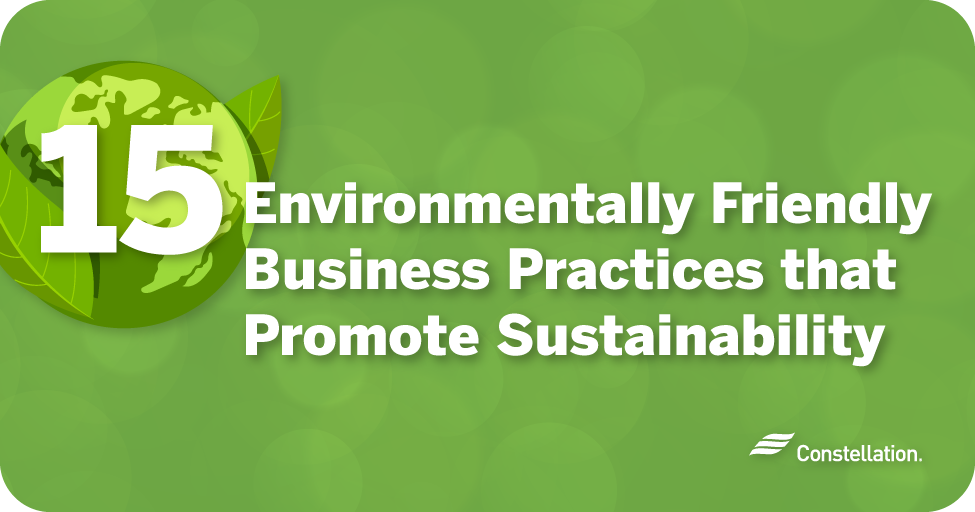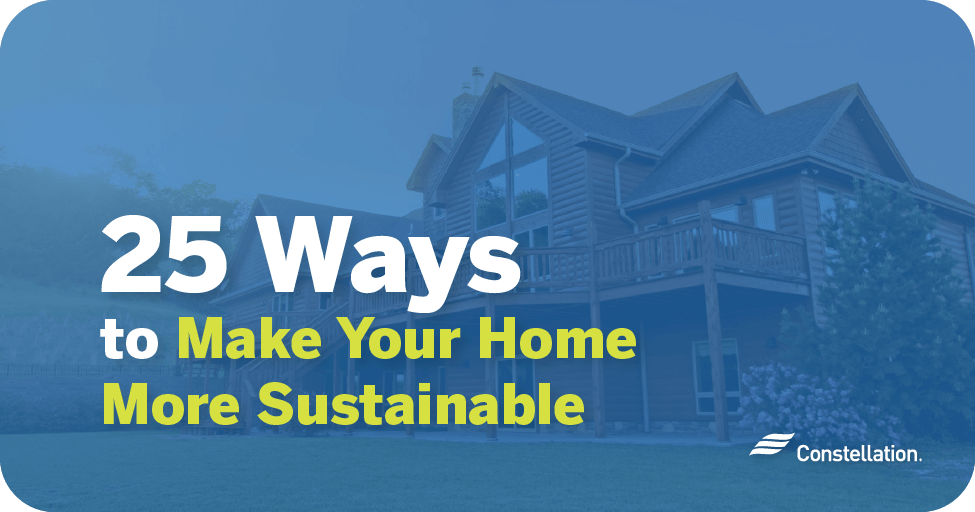
- Category:
Home Energy Savings - Published:
January 7, 2020 - Updated:
August 2, 2022
25 Ways to Make Your Home Sustainable
When you create a sustainable home, you are improving the environment and lowering the cost of running your home. Saving energy, water and maintenance on systems and appliances contribute to making a home sustainable. When you have a sustainable house, you create a healthier environment for yourself, family and pets, your community and your bank account.
- What is a sustainable home?
- What makes a house environmentally sustainable?
- Construction tips for building a sustainable house
- Home changes and improvements to support your sustainability goals
- Simple habits to help improve home sustainability
- Types of sustainable homes
What is a sustainable home?
A sustainable home is one that is built or retrofitted in a way that conserves resources, optimizes energy and water use and that will last longer with quality systems.
A sustainable house is built with low-impact, high-performance materials.They are efficient in terms of manufacturing, shipping and installing. Plus, because high-quality materials and systems break less and last longer, they produce less waste.
Energy efficiency is the key to home sustainability across the life of the structure. This article will take a deeper look at what makes a house sustainable, how to retrofit a conventional house and how to build a sustainable house when undertaking new construction. Plus we will share some sustainable home ideas that will help you think through how to make your home more sustainable.
What makes a house environmentally sustainable?
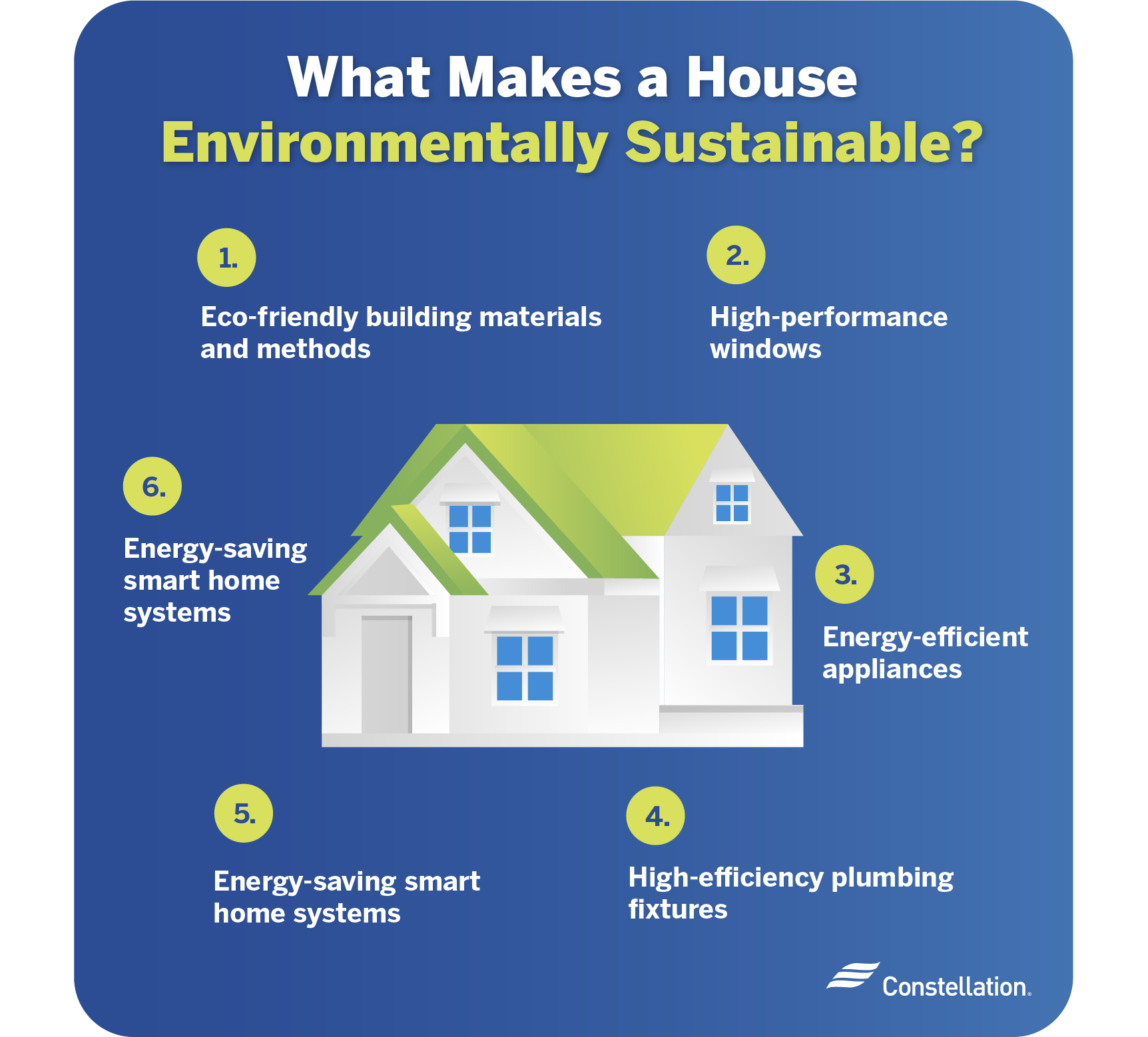
To make your house sustainable, consider every detail:
- Building materials and methods
- Decorating choices
- Insulation
- Windows
- Heat, ventilation and air conditioning
- Lighting
- Appliances
- Plumbing fixtures
- Use of smart systems
- Energy generation from solar and wind
- Your habits when it comes to regular maintenance, conservation and green cleaning
Construction tips for building a sustainable house
These tips on how to build a sustainable house will guide you in reducing waste, increasing durable reliability and improving energy and water efficiency over the lifespan of the home. Building in sustainable house features from the start will pay off in the long run.
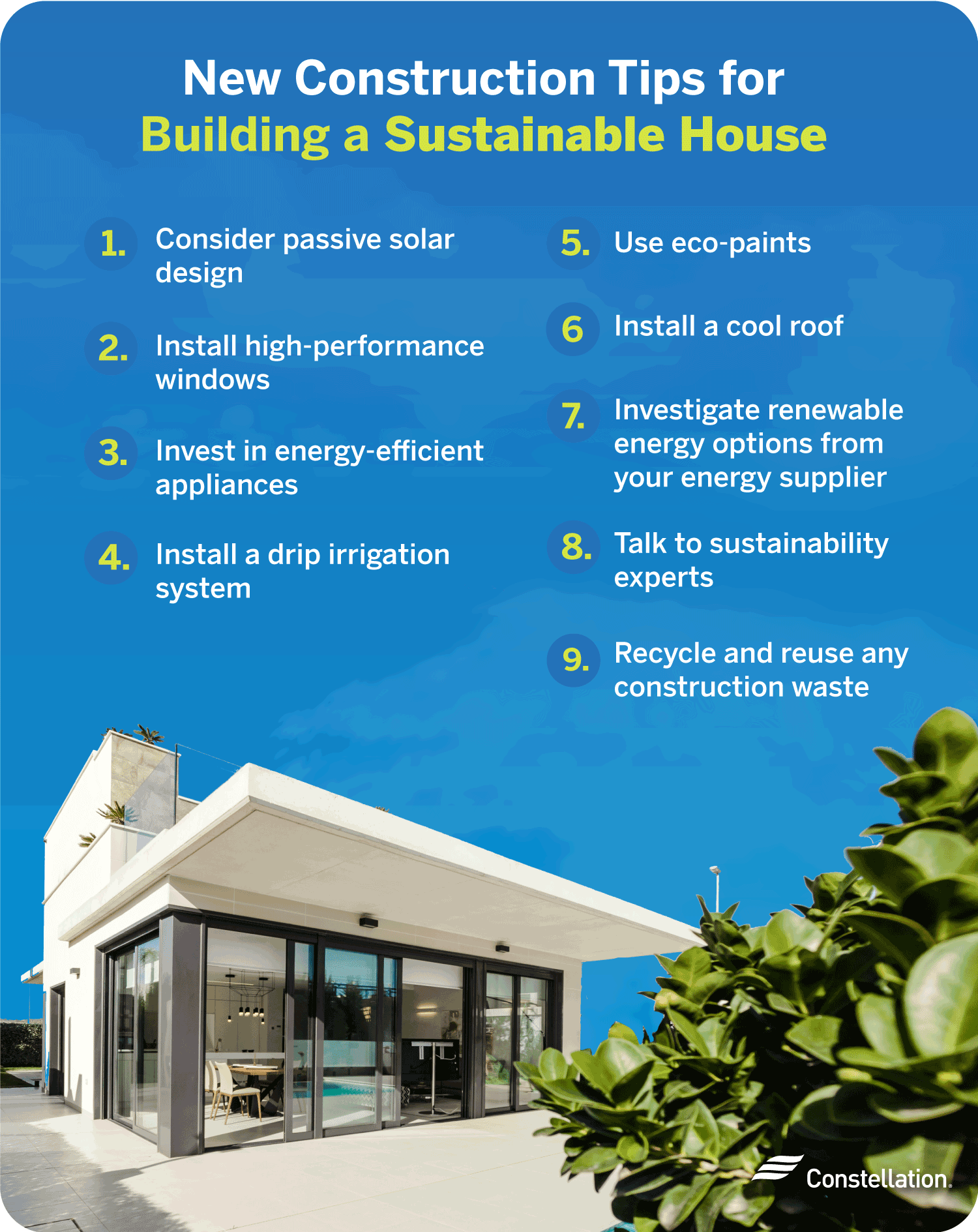
1. Consider passive solar design.
Passive solar design captures energy from the sun to help heat and cool your living spaces. Using no mechanical or electric equipment, passive solar design relies on building materials that reflect, absorb or transmit the sun’s radiation. Inside spaces are designed to facilitate the movement of sun-heated air without the use of fans. A passive house requires less energy to heat and cool.
2. Install high-performance windows.
High-performance windows can cut energy usage, as windows account for 50% or more of lost energy. New technologies include double glazing, special coatings, nonconductive framing materials and higher-quality, air-tight construction.
Replacing windows makes your home more energy-efficient, protects your belongings from fading, and makes rooms quieter.
- For a warmer climate: Look for what is called low solar gain, meaning less heat is conducted into your interior through the windows. Reflective technologies are very helpful, as is double glazing. Windows that also facilitate ventilation are ideal.
- For a colder climate: Choose frames that are well insulated and have the right U-value, which is the measure of the rate of heat flow through a material. Lower is better. Triple-glazed windows with a vacuum between panes can further minimize heat loss. Look for a tight fit to eliminate drafts.
3. Invest in energy-efficient appliances for your home.
After your HVAC systems, appliances are the next biggest energy consumers in your home. Think of them as having two prices: the cost of buying and the cost of operating. When you buy the most energy-efficient options, you dramatically cut the cost of using them, which can easily exceed the cost of buying them.
Use our home sustainability appliance guide and these appliance-specific tips to make energy-efficient choices:
- Refrigerators
- Dishwashers
- Stoves/ovens
- Air conditioners
- Clothes dryers
- Water heaters
- Electric car charging stations
4. Install a drip irrigation system.
What grows outside your house increases home sustainability. Landscaping choices can keep your home cooler, serve as a windbreak and contribute to cleaner air. Make choices that need less water and upkeep. Mowing lawns eats energy. If you are in an area where watering your landscape is necessary, drip irrigation is a sustainable home alternative. Drip irrigation systems use gravity to deliver water to plants, focusing it directly on the roots where it’s needed. You not only save electricity by eliminating water pumps but also minimize water wasted through evaporation.
5. Use eco-paints.
Use eco-paints in your sustainable house that emit fewer toxins. They reduce indoor air pollution and are less toxic to manufacture.
6. Install a cool roof.
A cool roof reflects the sun’s heat instead of absorbing it into your home. The effect on your cooling bill can be tremendous.
7. Investigate renewable energy options from your energy supplier.
Renewable energy is generated from naturally replenishing resources like the sun, wind, and water. Energy providers like Constellation are at the forefront of offering customers renewable options that provide you with the power you need in a way that is better for the environment.
8. Talk to sustainability experts.
Sustainability is an area of fast innovation in home building, home systems, appliances and lighting. Sustainability experts can perform an energy audit to give you advice on easy fixes and the latest technology.
9. Recycle and reuse any construction waste.
Don’t just get a dumpster and send your waste to a landfill. Save some materials for your own reuse. You can sell bricks, wood and metal, even old appliances that have a scrap value.
Simple home changes to support your sustainability goals
Making small improvements to increase sustainability at home can have a big impact. Many are relatively easy to fit into your budget, too.
10. Draft-proof your doors and windows.
Replace leaky weatherstripping and use foam tape to cover cracks. Eliminating gaps around the house that leak heat and cool air improves efficiency.
11. Invest in curtains or blinds.
Window treatments can block the sun and reflect back solar energy that heats up your house in the summer. In the winter, they can reduce drafts.
12. Reevaluate your home’s insulation.
A professional can give you advice on easy improvements, like foam injection, blown-in attic insulation and other options for insulating walls, floors and ceilings to create a more sustainable house.
13. Install solar panels.
Solar panels generate electricity you can use to power your home. By choosing energy sources like solar, you have a clean energy source that emits less carbon emissions than fossil fuels.
14. Clean your refrigerator’s coils.
Maintenance makes your refrigerator more efficient. It will draw less power and perform better if you keep the coils on the back free of dust and grime.
15. Install a water filter that removes microplastics.
Adding a filter to your washing machine will ensure that you aren’t adding microplastics to the environment. You can also filter your tap water coming into your home to keep microplastics out of your drinking water.
16. Replace fluorescent light bulbs with LED or CFL bulbs.
Offering longer life, greater energy efficiency and fewer toxic metals, these new bulbs are worth the switch. They are an easy way to increase sustainability at home.
17. Switch to smart power strips.
Use these in place of regular power strips to save energy. They sense when your device is in active use and cut power when it’s in standby. A smart home is a sustainable home.
18. Clean the filter on your clothes dryer.
A dirty filter is a fire hazard and a waste of energy. Clean it regularly for drier clothes and lower energy consumption.
Simple habits to support your sustainability goals
Upgrading your personal habits is just as effective in improving home sustainability as upgrading your appliances and systems.
19. Create a compost bin of kitchen scraps.
Composting keeps waste out of landfills and creates a nutrient-rich additive for your garden.
20. Plant an energy-efficient garden.
An energy-efficient garden minimizes water use. Choose hardy plants that don’t need frequent watering and use plenty of mulch. Collect rain water to use for drip irrigation.
21. Use cold water when washing your clothes.
High-efficiency washers and modern detergents get your clothes clean without using hot water. Your clothes will look newer longer if you avoid the fading and wear that hot water causes.
22. Buy recycled products.
Buying products made with recycled materials is good for the environment and creates more demand that encourages more recycling, fueling the circular economy.
23. Use dryer balls.
Dryer balls keep your clothes separated as they tumble, increasing airflow and dryer efficiency.
24. Line-dry your clothes.
Drying your clothes on a line outside the old-fashioned way uses less energy. If you miss the softness from drying items in your dryer, remove them from the line when they are nearly dry. Finish with a few minutes of tumbling in your dryer.
25. Use natural cleaning products.
Natural cleaning products keep toxins out of the water supply, out of your indoor air and off your skin.
7 types of sustainable and eco-friendly homes to get inspired by
Sustainable living in eco-friendly housing is increasingly sought after. A sustainable home can be just as functional and convenient as a conventional home. You don’t have to sacrifice style or comfort with today’s sustainable home features.
What are the different types of sustainable homes?
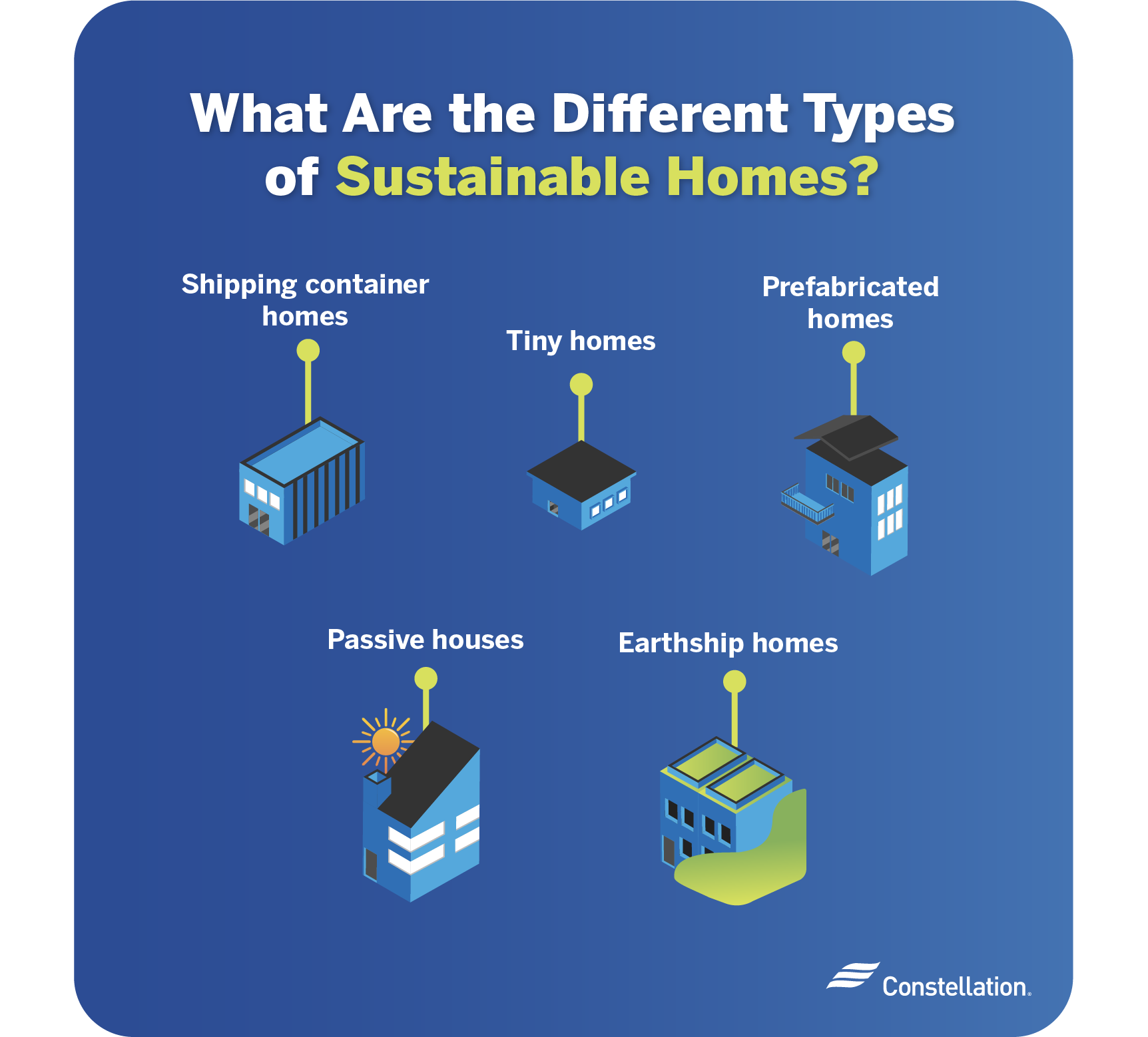
A sustainable home that uses fewer resources to build and is eco-friendly to live in is desirable among smart home buyers–and renters. Energy-saving new home features are built into some homes. You can add others to existing structures to improve home sustainability. Here are some of the most common sustainable house options and types of sustainable homes.
1. Shipping container homes
Using shipping containers to create homes recycles the containers in a way that is structurally strong and extremely energy efficient. Building is fast and doesn’t require a large number of added materials that need to be manufactured and shipped to your home site.
2. Zero-carbon homes
These homes are designed and built to use enough renewable energy that they offset the energy used to construct and run them. Their carbon footprint becomes zero over time. Using passive house technology and off-grid renewable energy plays a big part in making them sustainable.
3. Tiny homes
Downsizing to live in only the space you truly need creates a smaller, more efficient structure. You won’t have to pay to heat and air condition a large amount of space and tiny homes use fewer materials in construction.
4. Prefabricated homes
Houses that are designed and manufactured elsewhere are more efficient to build. Only assembly happens onsite. You can have expertly designed structures that use premium materials at a much lower price.
5. Passive houses
Passive homes make careful use of the sun’s energy to keep a house warm in the winter. They also use ventilation, materials and structural elements to keep the home cooler through the summer.
6. Straw bale homes
These structures are built of bricks of compressed straw that is sealed with a moisture barrier and finished with an attractive plaster outer layer. Because they’re made with a renewable material and because their thick walls offer superior insulation, straw bale homes are highly energy efficient.
7. Earthship homes
A large variety of natural and recycled materials go into building this kind of structure. Recycled aluminum cans, plastic bottles, tires and even cardboard are used. They have a high thermal mass and thick walls, combining to be energy efficient.
Make your home sustainable while enjoying long-term energy savings
By learning how to make your home more sustainable or how to build a sustainable house, you can contribute to a healthier environment. Add in renewable energy options like those offered by Constellation, and you have a sustainable home that will pay you back in energy savings as well as comfort.

